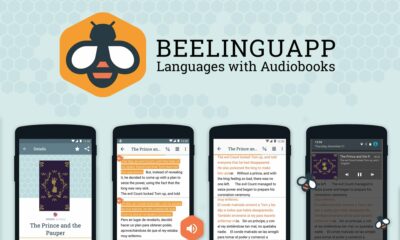SEO
5 Content Strategy Examples That Work (And Why)
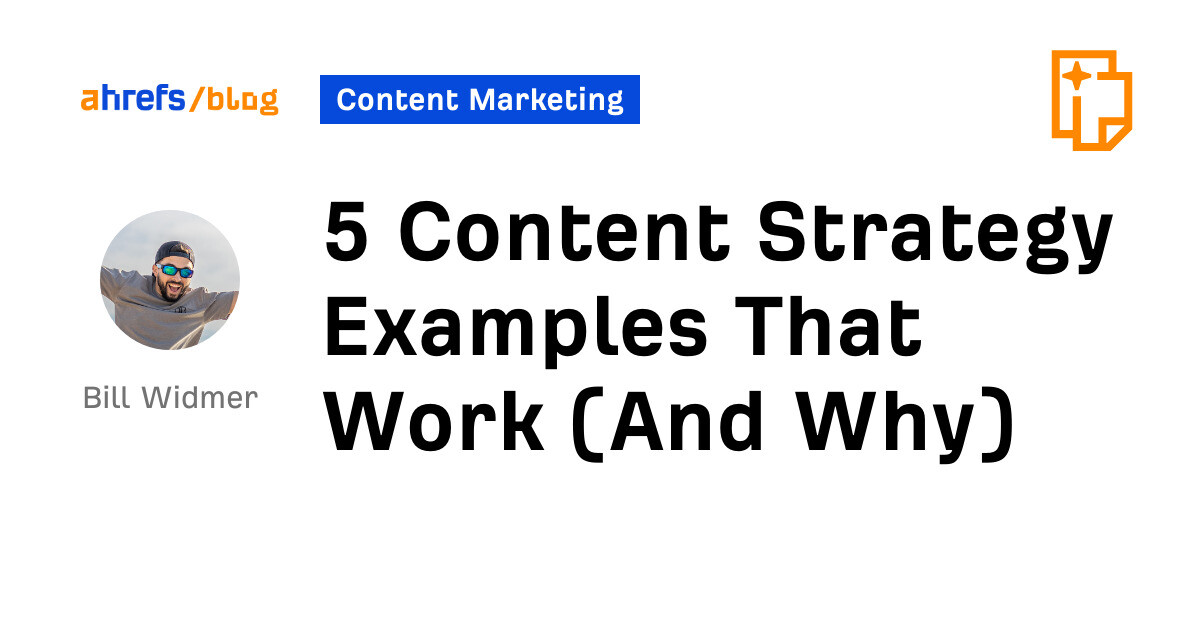
Nailing down your content strategy is one of the best ways to grow your business. But that’s easier said than done.
To help you with this, I want to dissect a few successful content strategy examples. Not only will we look at what content they create, but we’ll also look at why their strategies work and tips on implementing these strategies in your own marketing.
First up, I’d like to highlight our own content strategy here at Ahrefs. We rely almost solely on content to promote our product, which is an all-in-one SEO toolset.
Why us? Because our content marketing strategy was one of the main factors that grew our traffic to over 2.4M monthly visits from search engines (data from Ahrefs’ Site Explorer):
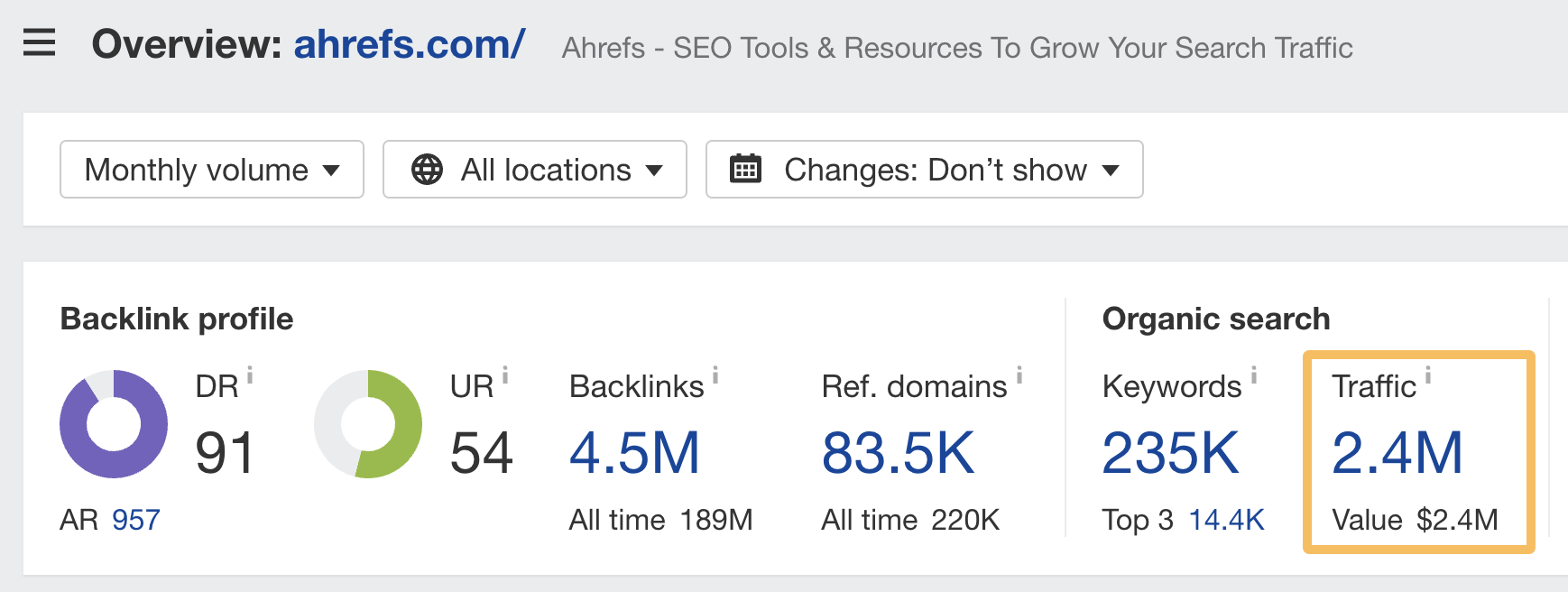
What is our strategy?
We focus on search engine optimization, i.e., creating content intended to rank on the front page of Google for keywords that help us promote our product.
We started with a focus on SEO-specific content, but we’ve since scaled our blog to cover other marketing topics, including content marketing, affiliate marketing, video marketing, and more.
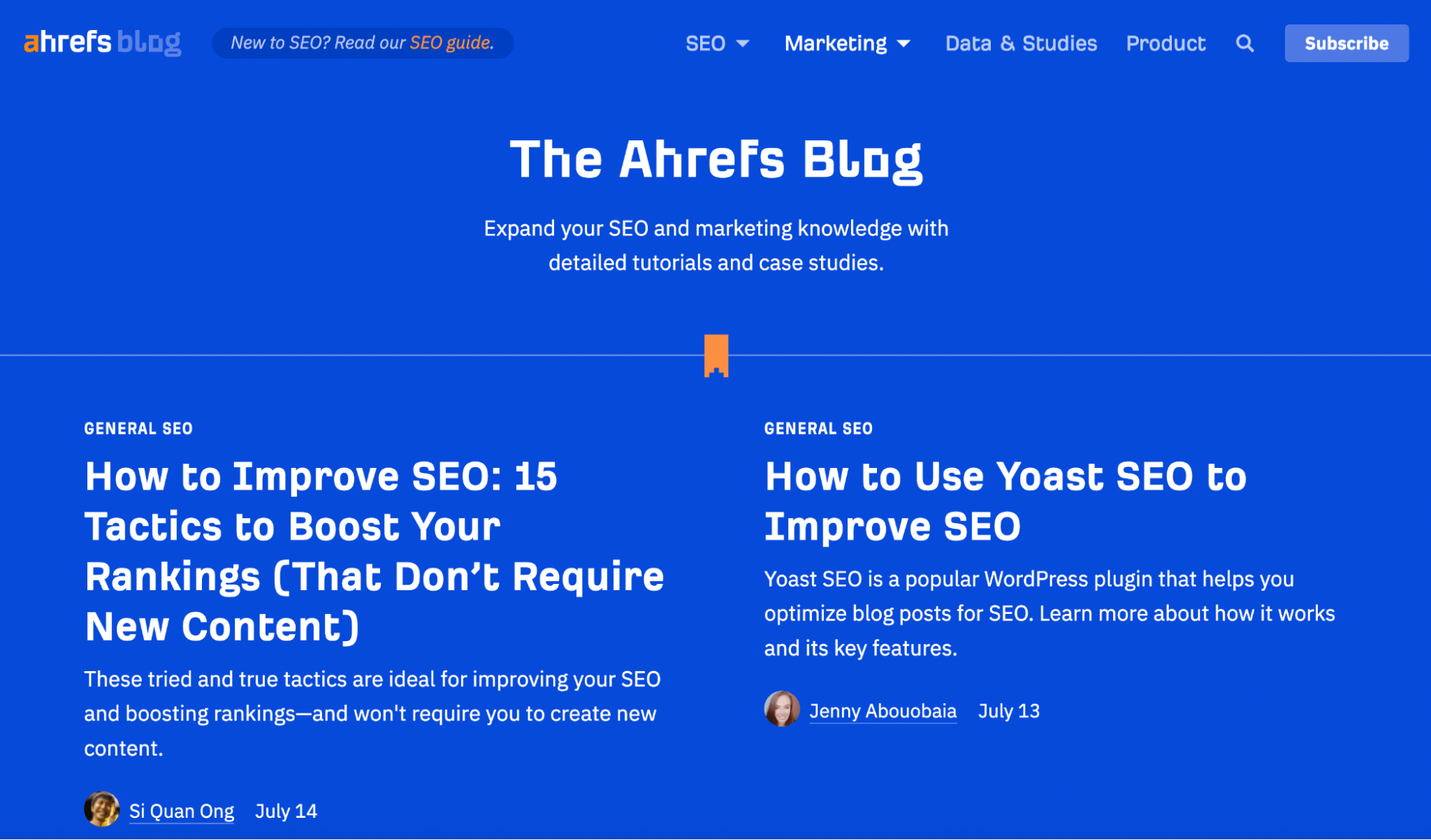
Our strategy begins with keyword research to determine what keywords our target audience is searching for. Then we create content that matches the search intent of those keywords.
Within that content, we promote our product whenever it’s relevant using screenshots, tutorials, helpful tips, and direct product promotion. You’re seeing an example of this right now.
When deciding which keywords to pursue, it’s a good idea to look at the business potential of that article. We typically follow this scoring system when choosing our next topics:
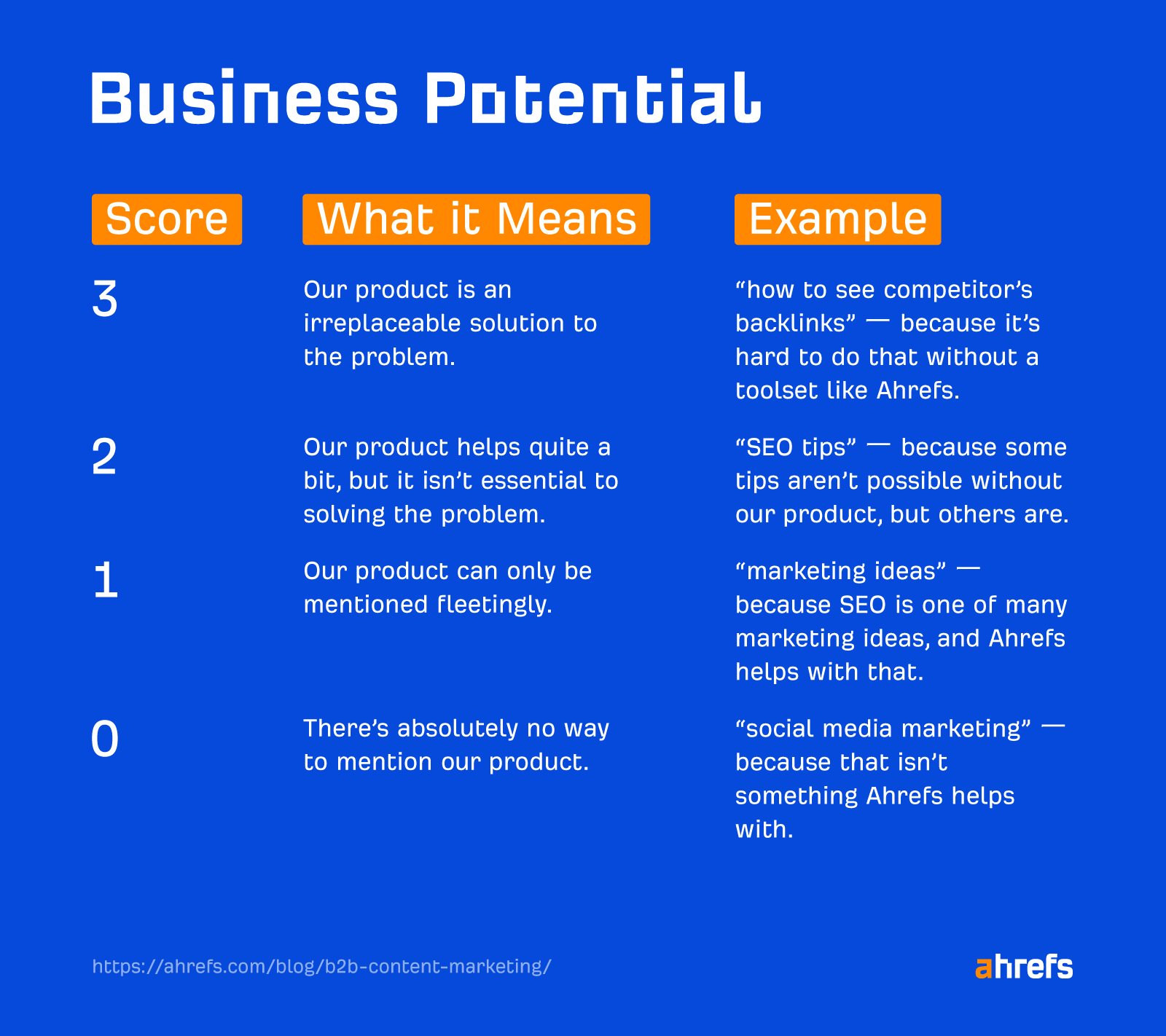
Why does it work so well?
Our SEO strategy works so well because our content (and our tools) is extremely useful to anyone who wants to learn and implement SEO on their own website.
We also already have a strong backlink portfolio, which is one of Google’s most important ranking factors. While many niches are less competitive and don’t require nearly as many links to compete, the SEO niche is highly competitive, and we need the backlinks to outrank our competitors.
Lastly, we have rigorous editorial standards to make sure our content is epic, and we check all the boxes for technical SEO.
How can you implement our strategy?
If you want to reap the benefits of passive, recurring traffic (and customers), then SEO is the way to go.
I recommend reading our beginner’s guide to SEO. But beyond that, here are some other guides to get you started:
It’s also a good idea to understand how the Google search algorithm works so you have a better shot at ranking in that coveted first position.
The Tonic is a daily email newsletter with over 17K subscribers, and it grosses more than $5K in monthly revenue.
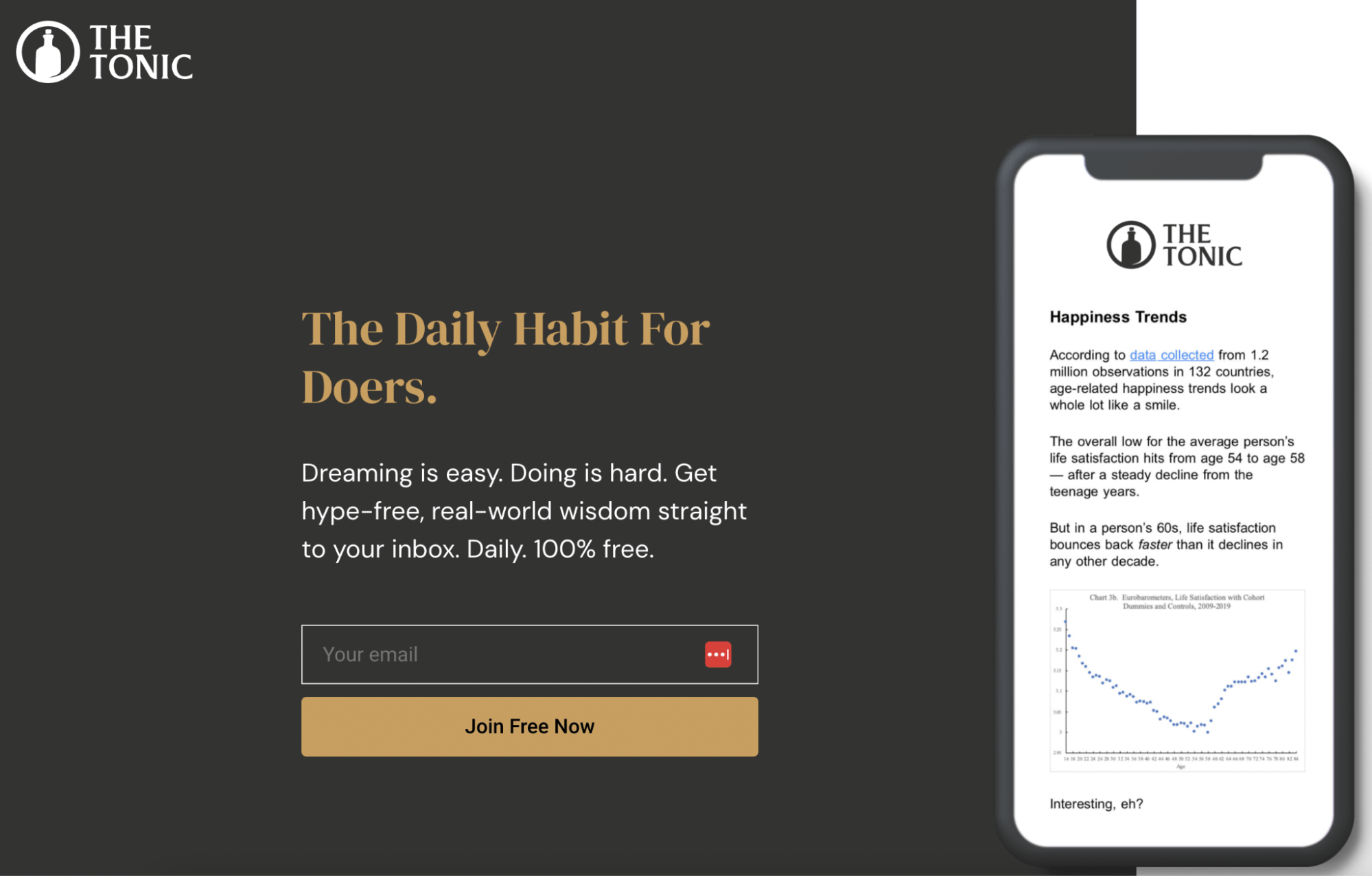
It’s achieved some impressive numbers for a newsletter that’s sent so frequently:
- Five emails sent per week
- A 33% open rate
- Growing at a rate of 2K subs per month
- 0.1% unsubscribe rate per email
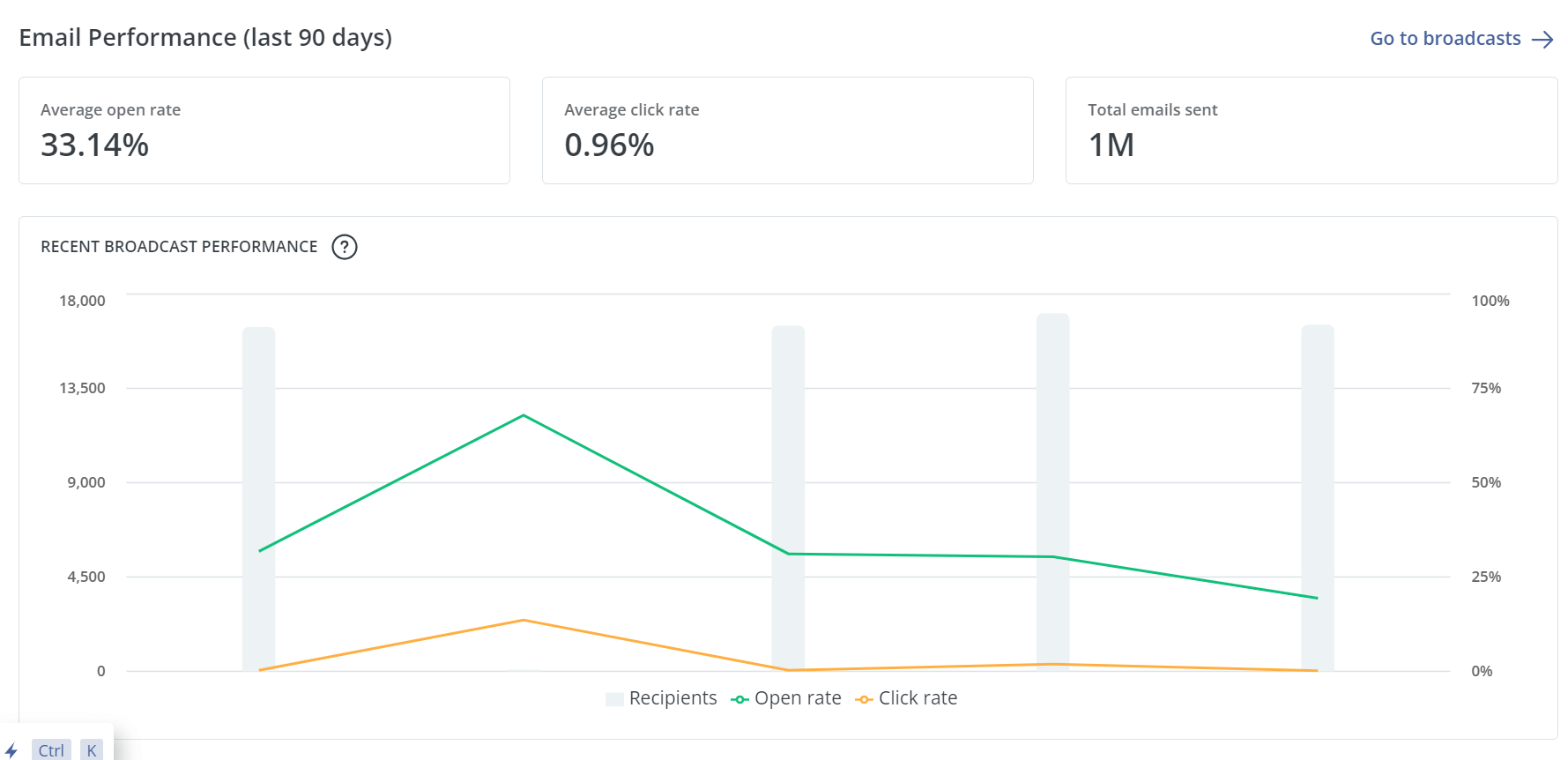
What is its strategy?
The bulk of its growth comes from Facebook ads leading to conversion-focused blog articles.
In fact, Mike Blankenship (co-founder of The Tonic) shared exactly how the company got 834 subscribers in less than two weeks for just $24.68:
Basically, it wrote this article, which had an extremely clickable title…

… and ended with a non-intrusive call to action to join the newsletter.
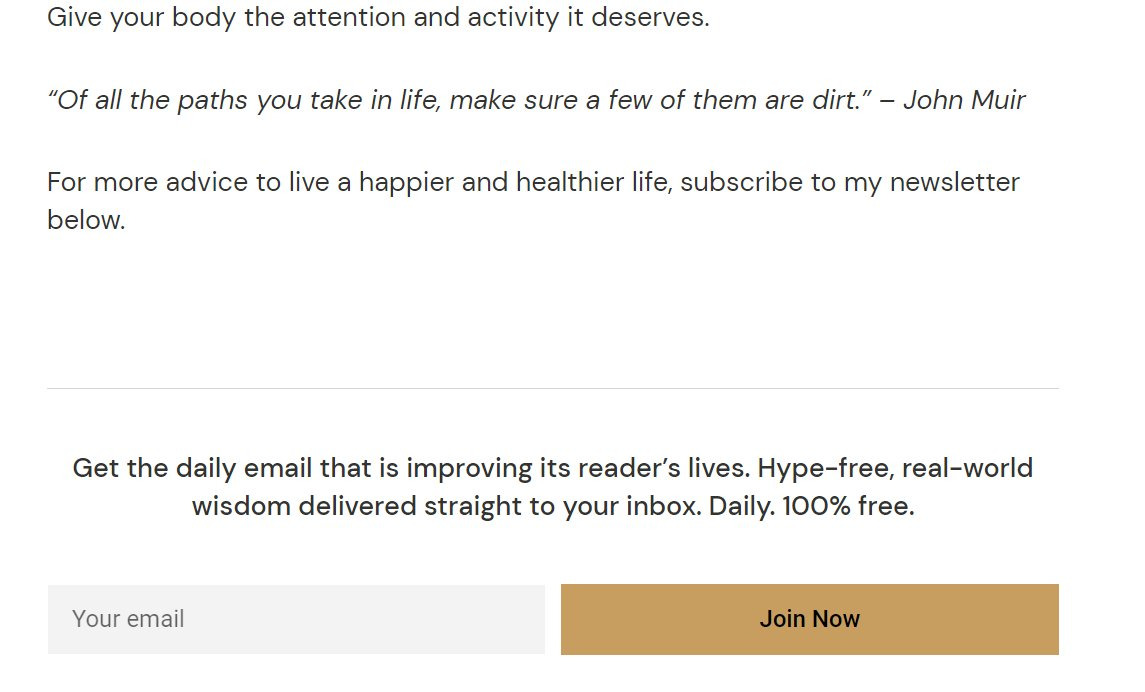
Finally, it created the following Facebook ad to drive traffic to its content:
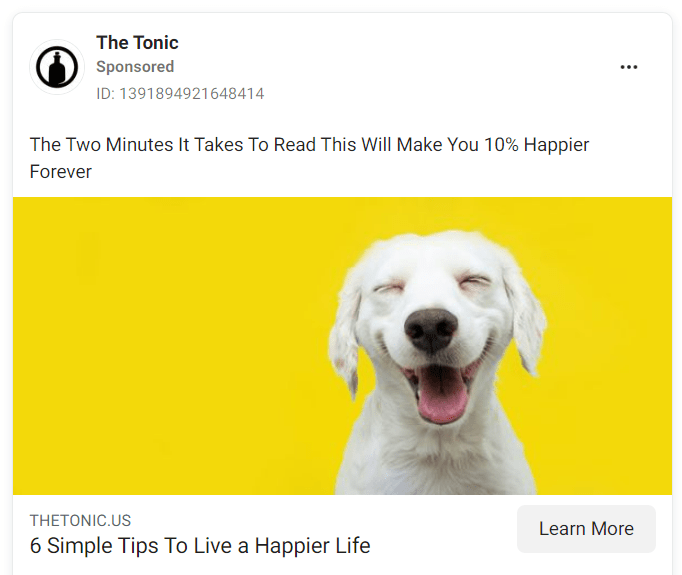
Why does it work so well?
In today’s fast-paced, information-overloaded world, people crave instant gratification. They want the answer, and they want it now.
So The Tonic gives it to them.
The title of the article, “The Two Minutes It Takes You To Read This Will Make You 10% Happier Forever,” screams to be read. Can you really afford not to read something with such a low commitment and a high potential payoff?
It works so well because of simplicity and excellent copy.
The bold yellow background of the ad makes it stand out in the sea of junk as you’re scrolling, the title is compelling, and the article delivers on the promise, making people want to subscribe.
How can you implement its strategy?
First, take five minutes to skim through my writing tips. They’re not specific to ad copy, but some do still apply. Plus, you can never waste time learning to become a better writer.
Then brainstorm landing page ideas for your Facebook ad. What is something you can write that is to the point, intriguing, and useful?
Here are a few random examples in different niches:
- Learn how to prevent pet cataracts in two minutes
- This one tip could save you thousands on car repairs
- You’ll never believe what they put in your bread
Basically, you want to come up with a title that captivates your target audience and requires an extremely low commitment to read. We don’t want ultimate guides or 57 tips here—remember, KISS. Keep it super simple.
Finally, when writing the landing page, keep it short and useful and end it with your call to action once you have the reader hooked.
Red Bull is one of the savviest marketing companies I’ve ever seen.
Its content strategy involves getting you to like, share, and subscribe to videos on every platform—and it’s crushing it, with millions of subscribers on each platform.

It also happens to get over 3.5M visits from organic search every month.

What is its strategy?
Red Bull excels at creating viral, on-brand video content across a wide array of mediums, including TikTok, Instagram, YouTube, and even traditional TV advertising.
But, unlike our strategy at Ahrefs, it isn’t directly promoting its products in this content. Instead, it’s focusing on getting its brand name and logo in front of giant audiences.
The hope is that you’ll grab a Red Bull instead of a Monster or another competitor when you see it because you’ve watched its content and recognize its brand more than the others.
It even has different channels for different sports, such as Red Bull Bike for bike sports, Red Bull Skateboarding for skateboarding, etc.
Amazingly, those channels also have over a million subscribers each.
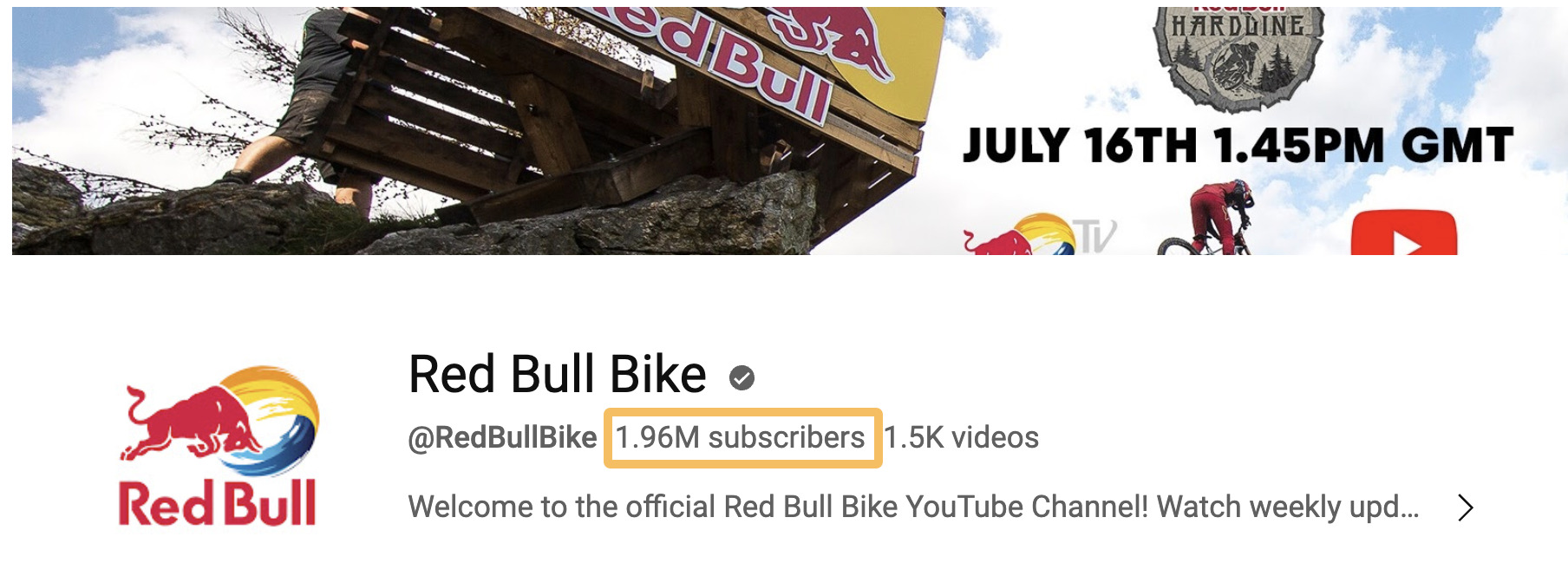
Why does it work so well?
Red Bull’s videos and brand align perfectly—they are all about high-energy, high-intensity activities like skydiving and other extreme sports. The videos perform well because some of the things it films people doing are so wildly extreme that it’s actually hard to believe it’s real.
Take this video, for example, where Red Bull sends Felix Baumgartner to low orbit in a helium-filled balloon and has him jump out of it. Yes, you heard that right—he’s space-diving.
Or this TikTok video, where it built a skate park on a hot air balloon, and Kriss Kyle rode his bike around it over a mile above the ground:
These videos work so well not because they’re good at promoting Red Bull’s products specifically, but because they’re able to go viral and spread brand awareness of the company through sheer numbers.
Sometimes, marketing isn’t about providing the best information to help people find your product; it’s about aligning your brand with your ideal customer and getting in front of them in any way possible.
How can you implement its strategy?
Obviously, I don’t expect your brand to have the kind of marketing budget Red Bull has.
But you can still learn from its strategy—namely, that if you’re focusing on social media, you need to learn to create viral videos.
Ask yourself: What does my target market care about, and how can I get in front of it? Brainstorm a list of ideas that could be great attention-grabbers. Think outside the box and go check out other viral video creators in your niche to get ideas.
To learn more, check out our guide to video marketing.
Bank My Cell is a site where you can trade in your old cell phone for cash. Like Ahrefs, it also focuses on SEO as its main content strategy—to the tune of 324K monthly organic traffic.
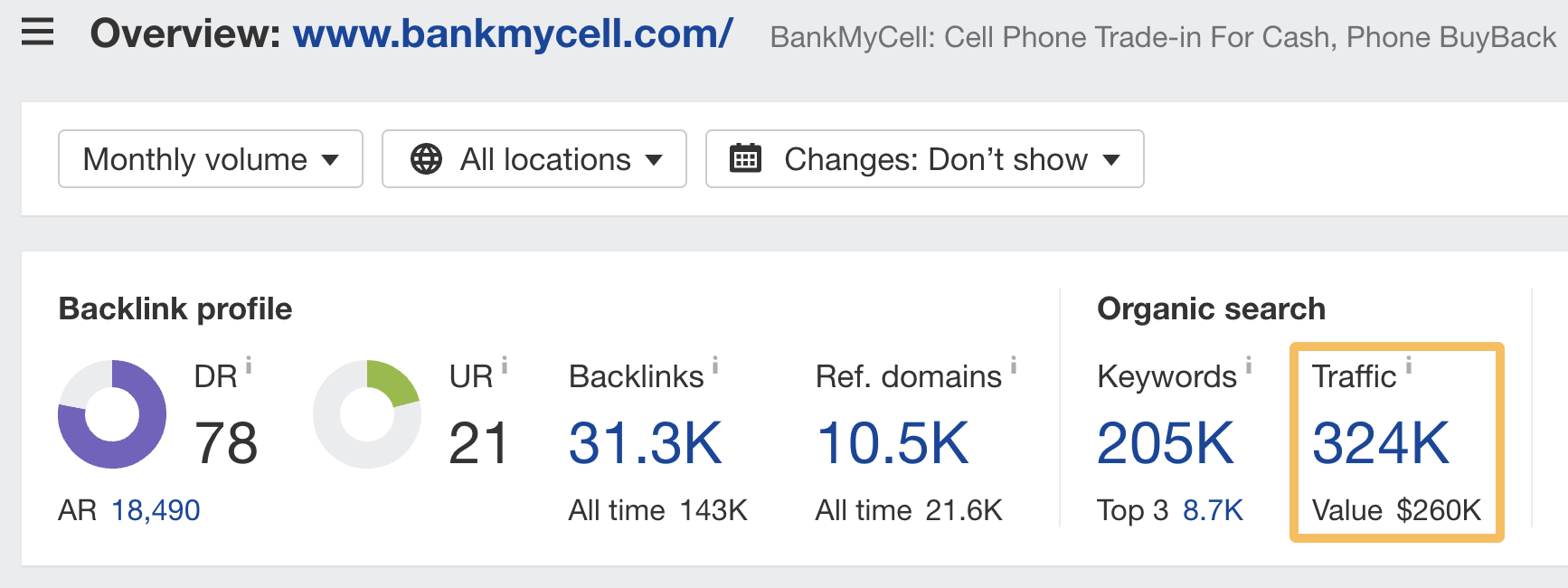
However, its approach is a little different.
What is its strategy?
Bank My Cell’s strategy focuses heavily on two things: link building and topical authority.
In the first few years of the site’s existence, it struggled to gain traction. As you can see in the chart below, despite publishing more content (yellow line) and building links steadily (blue line), its traffic (orange line) remained relatively flat and even on the downtrend.
That is, until December of 2020, when it started publishing informational content like crazy in order to achieve topical authority.
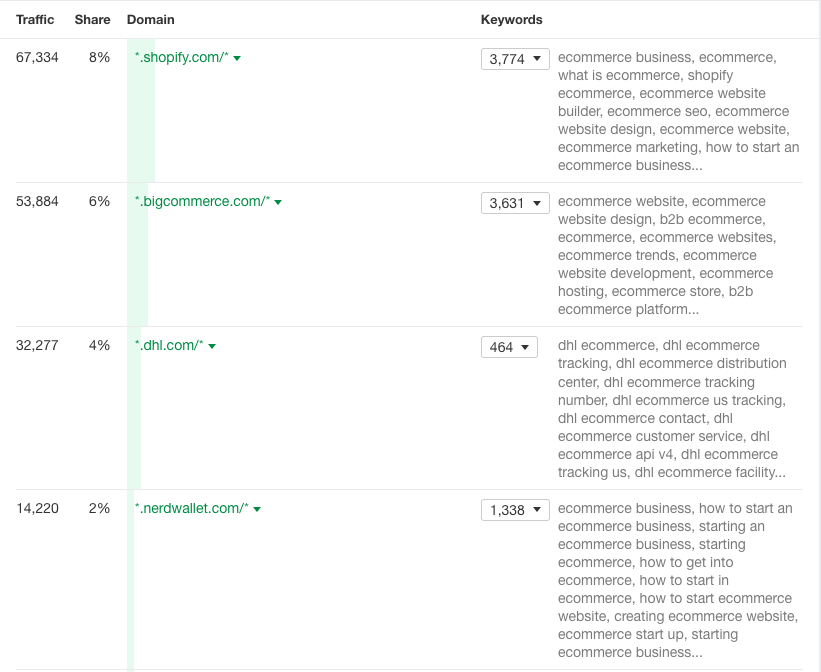
Before that time, it only had money pages on its site. After that, it filled out its site with content like “how to factory reset your iphone” and “how to tell what model iphone you have.”
As you can see, it led to a massive boost in organic traffic.
In addition to this new content, it also utilized digital PR and statistic pages to build high-quality backlinks to the website.
For example, its “how many people have smartphones” page has over 9K backlinks—many of which are from high-DR websites. This one page alone is enough to put it on the map for most of its target keywords.

Why does it work so well?
The informational content Bank My Cell published helped it appear as an authority in the eyes of Google, improving rankings across the board.
Better still, these info pages, once ranking well, acquired natural backlinks from other websites on autopilot—creating an upward spiral effect.
Combine this with the links its PR and statistic pages pulled in, and you have a recipe for easy page #1 rankings on all its keywords (data from Ahrefs’ Site Explorer):
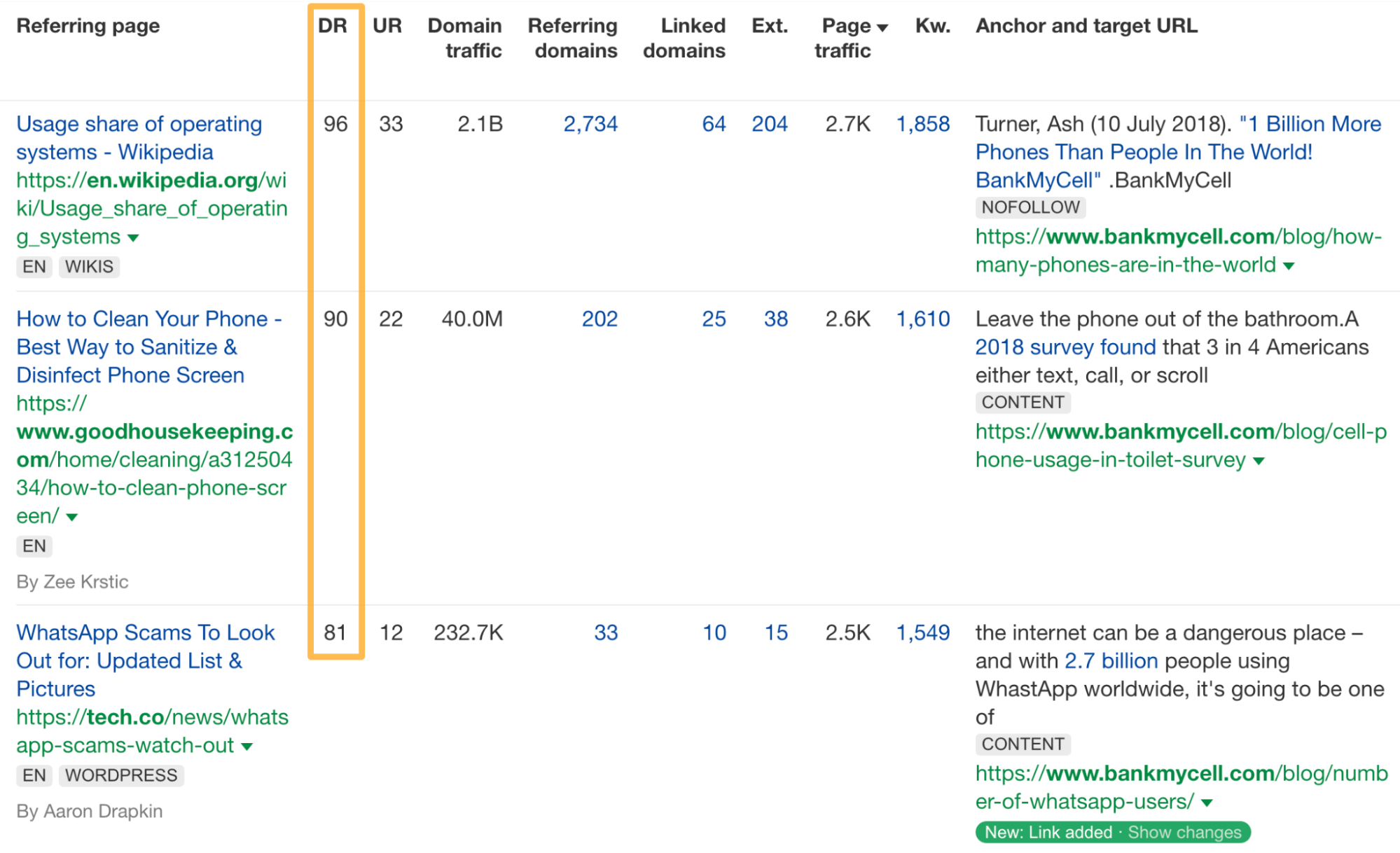
How can you implement its strategy?
Begin by figuring out the topical authority coverage of you and your competitors.
Measuring topical authority is difficult. But Kevin Indig devised a way of roughly calculating topical authority using the Traffic share by domains report in Ahrefs’ Keywords Explorer, which shows traffic share percentages of the major players in your niche:

Here’s how you can do this in your niche:
- Take a head term like “ecommerce” and enter it in Keywords Explorer
- Go to the Matching terms report and filter for a minimum volume of 10
- Export all keywords and reupload them into Keywords Explorer
- Go to Traffic share by domains
Traffic share = topic share, aka “topical authority.” You can use this analysis to see who in your niche has the most topical authority and what keywords they’re ranking for.
Then, you can take these competing sites and perform a content gap analysis to see what keywords they’re ranking for that you aren’t—revealing the holes in your topical coverage.
To do that, head to Site Explorer and click “Content gap.” Enter your competitors into the tool.
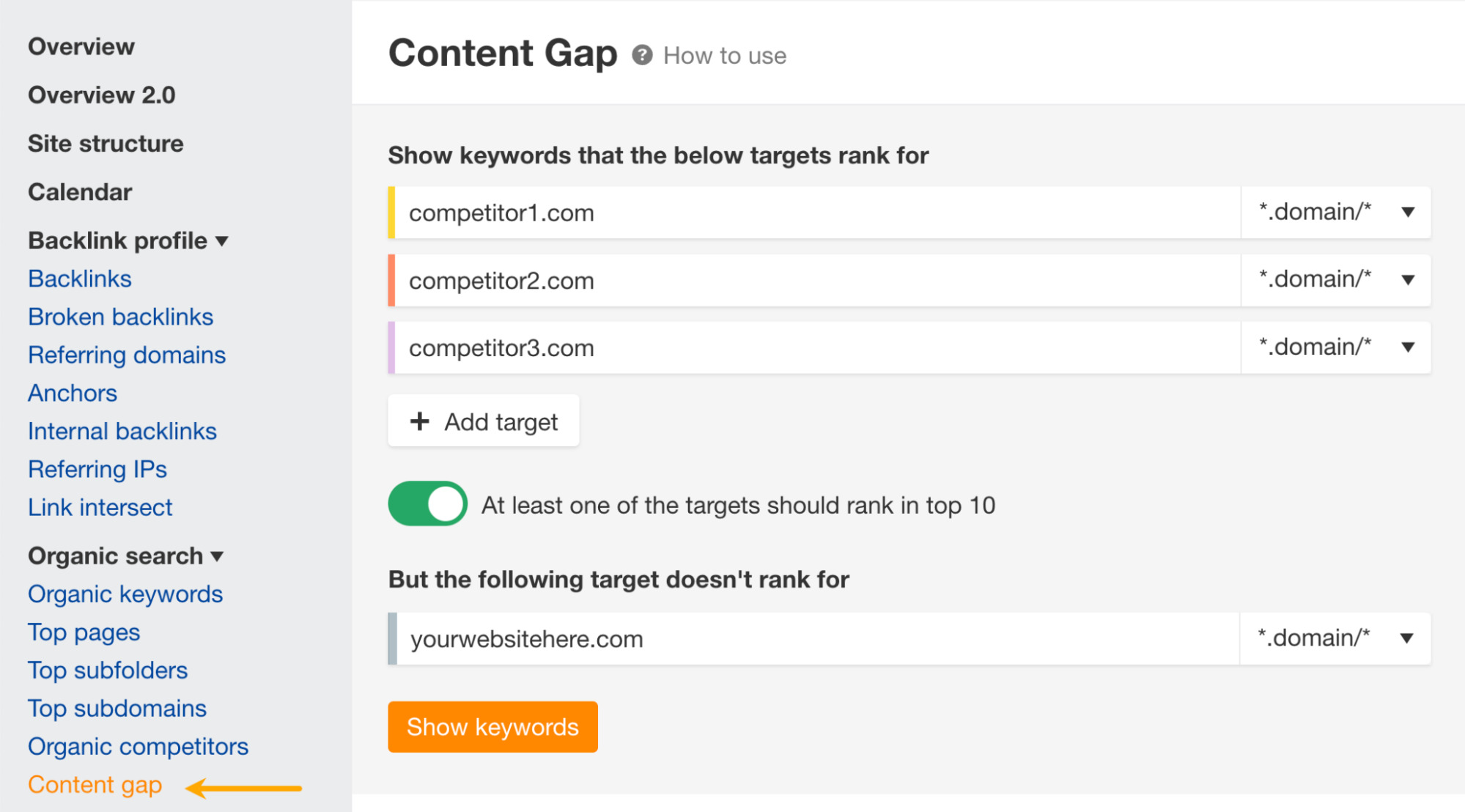
Once you click “Show keywords,” you’ll be taken to a list of keywords that those competing websites rank for, but yours doesn’t.
Let’s run through this on one of my sites.
In just the first 10 keywords, I realized I haven’t yet talked about tent air conditioners, lifted 4Runners, or Jeep Wrangler builds.
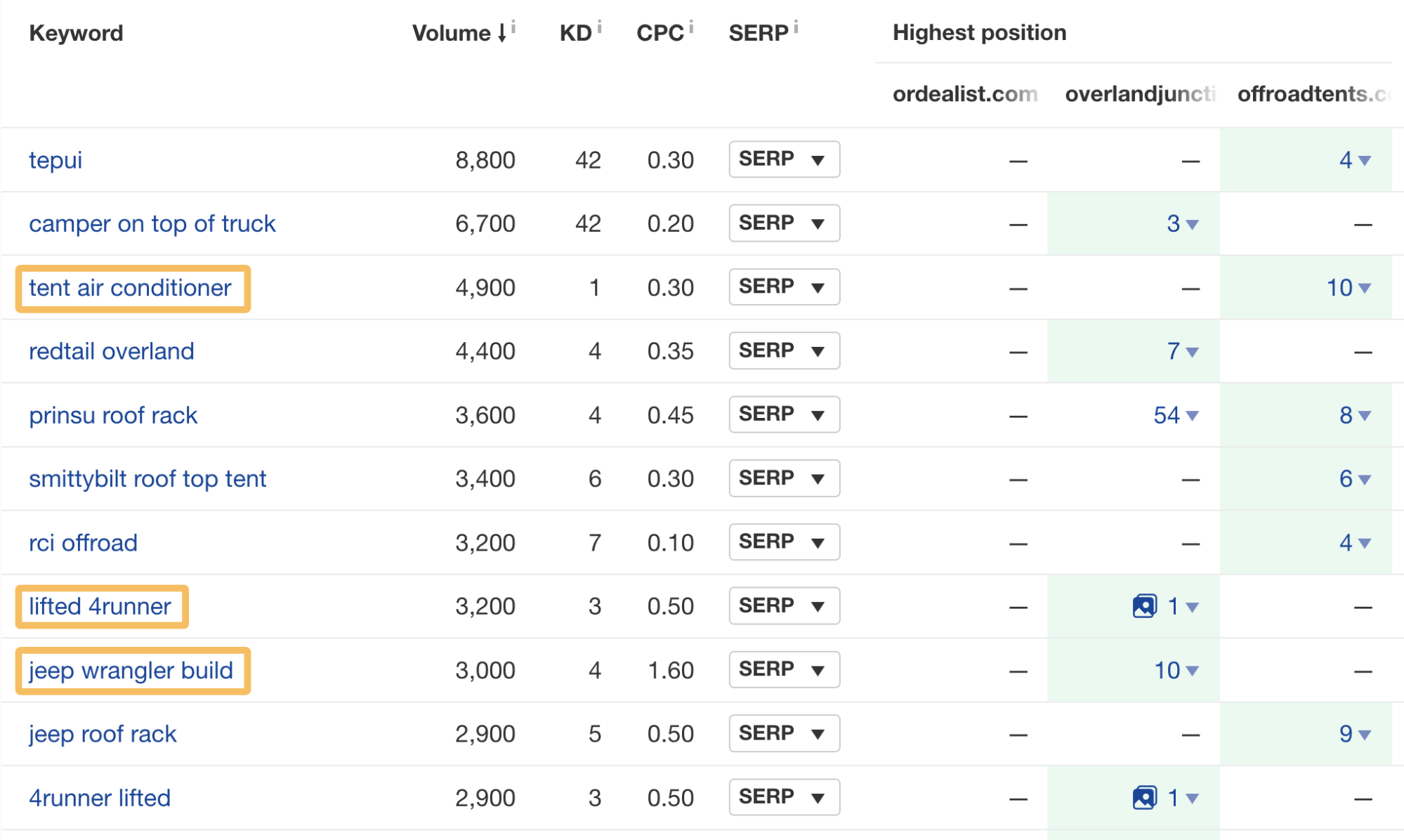
I’ve written about lifted Tacomas, tent fans, and Jeep Wrangler gear on my site, so publishing content targeting these gap keywords can improve my topical authority.
Another thing you can do to emulate Bank My Cell’s content strategy is to create statistic pages that journalists, news websites, and other bloggers want to link to.
We’ve done this at Ahrefs by making our SEO statistics page, which has acquired over 4.5K backlinks from 2K referring domains.

Follow our guide to statistic page link building to learn how you can do this too.
Airbnb grosses over $8.4B every year, and that number is growing fast. It owes its start—and much of its current growth—to a strong content strategy.
What is its strategy?
Airbnb’s content strategy started with a mix of destination guides, user-submitted stories and photos, and a strong social media presence.
Today, it thrives on user-generated content (UGC) to promote the business. Both Airbnb hosts and their guests are posting their homes and stays online.
Airbnb often reposts its customers’ posts that showcase their Airbnb properties:
Airbnb guests also share photos and videos of their experience, further promoting the company.
Why does it work so well?
UGC works so well for Airbnb because it encourages that through contests and by showcasing the customers’ photos and videos on its social media platforms and website.
This capitalizes on people’s desire to feel special and interesting. When you see a big brand name share your content, it makes you feel good.
Also, it makes sense for hosts to want to post about their rental properties on social media because it helps them make more money for their own business—it’s a win-win.
How can you implement its strategy?
Besides running UGC contests to encourage your customers to post about you, you should also build your business in a way that naturally encourages UGC.
For instance, fashion brands—particularly high-status ones—naturally encourage UGC because people want to post themselves wearing these clothes to show off.
If your products photograph or video well, then create a hashtag, run some contests, and engage with your users. They appreciate the shout-out, and you get free content.
Final thoughts
The right content strategy can scale your business and bring you passive income. Whether you choose to use SEO, social media, or another strategy, content is still king.
These content strategy examples are just the tip of the iceberg. If you want to learn more, be sure to check out our complete guide to creating a winning content strategy.
Comments? Questions? Ping me on Twitter.
SEO
Executive Director Of WordPress Resigns

Josepha Haden Chomphosy, Executive Director of the WordPress Project, officially announced her resignation, ending a nine-year tenure. This comes just two weeks after Matt Mullenweg launched a controversial campaign against a managed WordPress host, which responded by filing a federal lawsuit against him and Automattic.
She posted an upbeat notice on her personal blog, reaffirming her belief in the open source community as positive economic force as well as the importance of strong opinions that are “loosely held.”
She wrote:
“This week marks my last as the Executive Director of the WordPress project. My time with WordPress has transformed me, both as a leader and an advocate. There’s still more to do in our shared quest to secure a self-sustaining future of the open source project that we all love, and my belief in our global community of contributors remains unchanged.
…I still believe that open source is an idea that can transform generations. I believe in the power of a good-hearted group of people. I believe in the importance of strong opinions, loosely held. And I believe the world will always need the more equitable opportunities that well-maintained open source can provide: access to knowledge and learning, easy-to-join peer and business networks, the amplification of unheard voices, and a chance to tap into economic opportunity for those who weren’t born into it.”
Turmoil At WordPress
The resignation comes amidst the backdrop of a conflict between WordPress co-founder Matt Mullenweg and the managed WordPress web host WP Engine, which has brought unprecedented turmoil within the WordPress community, including a federal lawsuit filed by WP Engine accusing Mullenweg of attempted extortion.
Resignation News Was Leaked
The news about the resignation was leaked on October 2nd by the founder of the WordPress news site WP Tavern (now owned by Matt Mullenweg), who tweeted that he had spoken with Josepha that evening, who announced her resignation.
He posted:
“I spoke with Josepha tonight. I can confirm that she’s no longer at Automattic.
She’s working on a statement for the community. She’s in good spirits despite the turmoil.”
Screenshot Of Deleted Tweet
Josepha tweeted the following response the next day:
“Ok, this is not how I expected that news to come to y’all. I apologize that this is the first many of you heard of it. Please don’t speculate about anything.”
Rocky Period For WordPress
While her resignation was somewhat of an open secret it’s still a significant event because of recent events at WordPress, including the resignations of 8.4% of Automattic employees as a result of an offer of a generous severance package to all employees who no longer wished to work there.
Read the official announcement:
Featured Image by Shutterstock/Wirestock Creators
SEO
8% Of Automattic Employees Choose To Resign
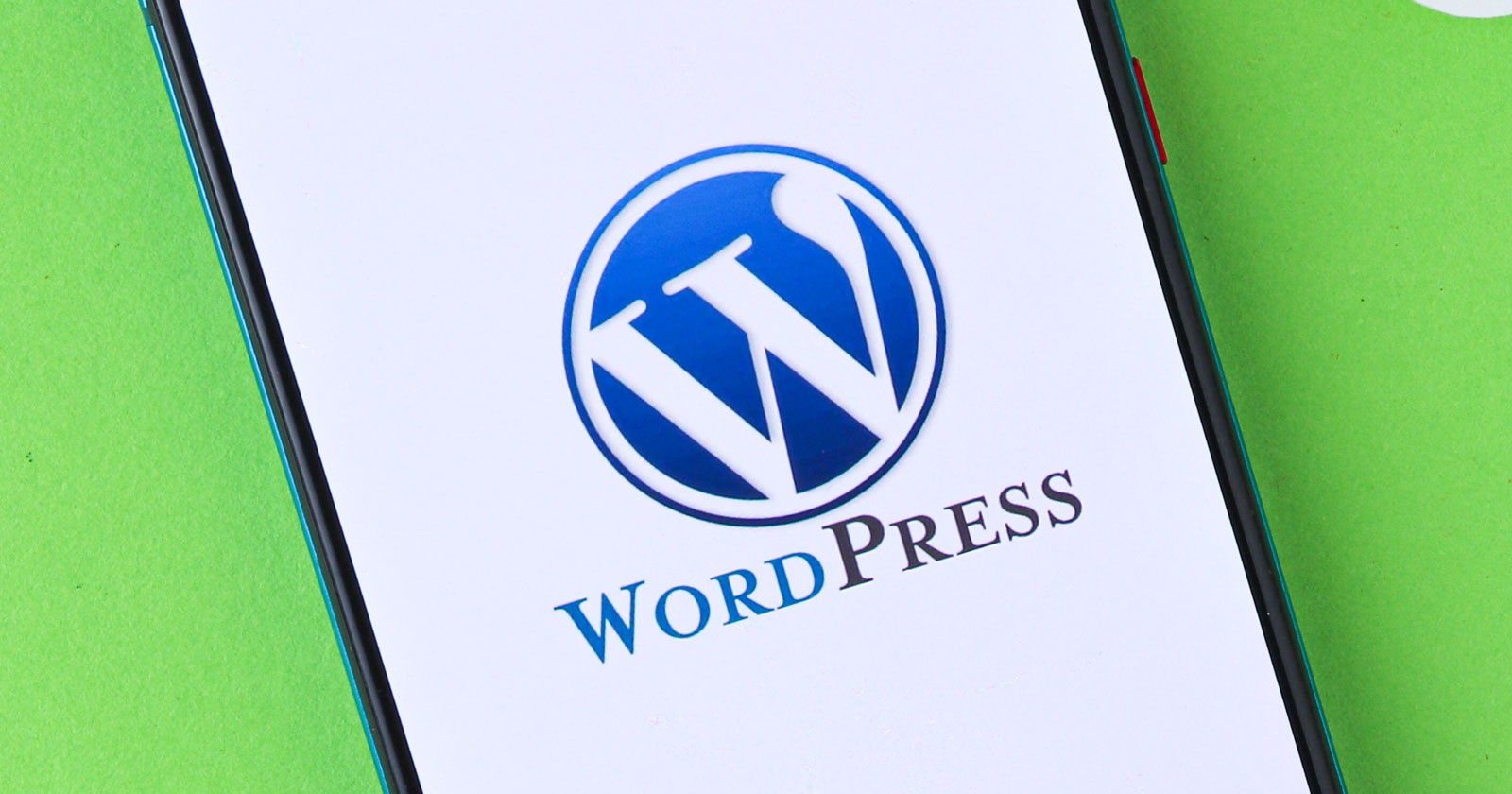
WordPress co-founder and Automattic CEO announced today that he offered Automattic employees the chance to resign with a severance pay and a total of 8.4 percent. Mullenweg offered $30,000 or six months of salary, whichever one is higher, with a total of 159 people taking his offer.
Reactions Of Automattic Employees
Given the recent controversies created by Mullenweg, one might be tempted to view the walkout as a vote of no-confidence in Mullenweg. But that would be a mistake because some of the employees announcing their resignations either praised Mullenweg or simply announced their resignation while many others tweeted how happy they are to stay at Automattic.
One former employee tweeted that he was sad about recent developments but also praised Mullenweg and Automattic as an employer.
He shared:
“Today was my last day at Automattic. I spent the last 2 years building large scale ML and generative AI infra and products, and a lot of time on robotics at night and on weekends.
I’m going to spend the next month taking a break, getting married, and visiting family in Australia.
I have some really fun ideas of things to build that I’ve been storing up for a while. Now I get to build them. Get in touch if you’d like to build AI products together.”
Another former employee, Naoko Takano, is a 14 year employee, an organizer of WordCamp conferences in Asia, a full-time WordPress contributor and Open Source Project Manager at Automattic announced on X (formerly Twitter) that today was her last day at Automattic with no additional comment.
She tweeted:
“Today was my last day at Automattic.
I’m actively exploring new career opportunities. If you know of any positions that align with my skills and experience!”
Naoko’s role at at WordPress was working with the global WordPress community to improve contributor experiences through the Five for the Future and Mentorship programs. Five for the Future is an important WordPress program that encourages organizations to donate 5% of their resources back into WordPress. Five for the Future is one of the issues Mullenweg had against WP Engine, asserting that they didn’t donate enough back into the community.
Mullenweg himself was bittersweet to see those employees go, writing in a blog post:
“It was an emotional roller coaster of a week. The day you hire someone you aren’t expecting them to resign or be fired, you’re hoping for a long and mutually beneficial relationship. Every resignation stings a bit.
However now, I feel much lighter. I’m grateful and thankful for all the people who took the offer, and even more excited to work with those who turned down $126M to stay. As the kids say, LFG!”
Read the entire announcement on Mullenweg’s blog:
Featured Image by Shutterstock/sdx15
SEO
YouTube Extends Shorts To 3 Minutes, Adds New Features
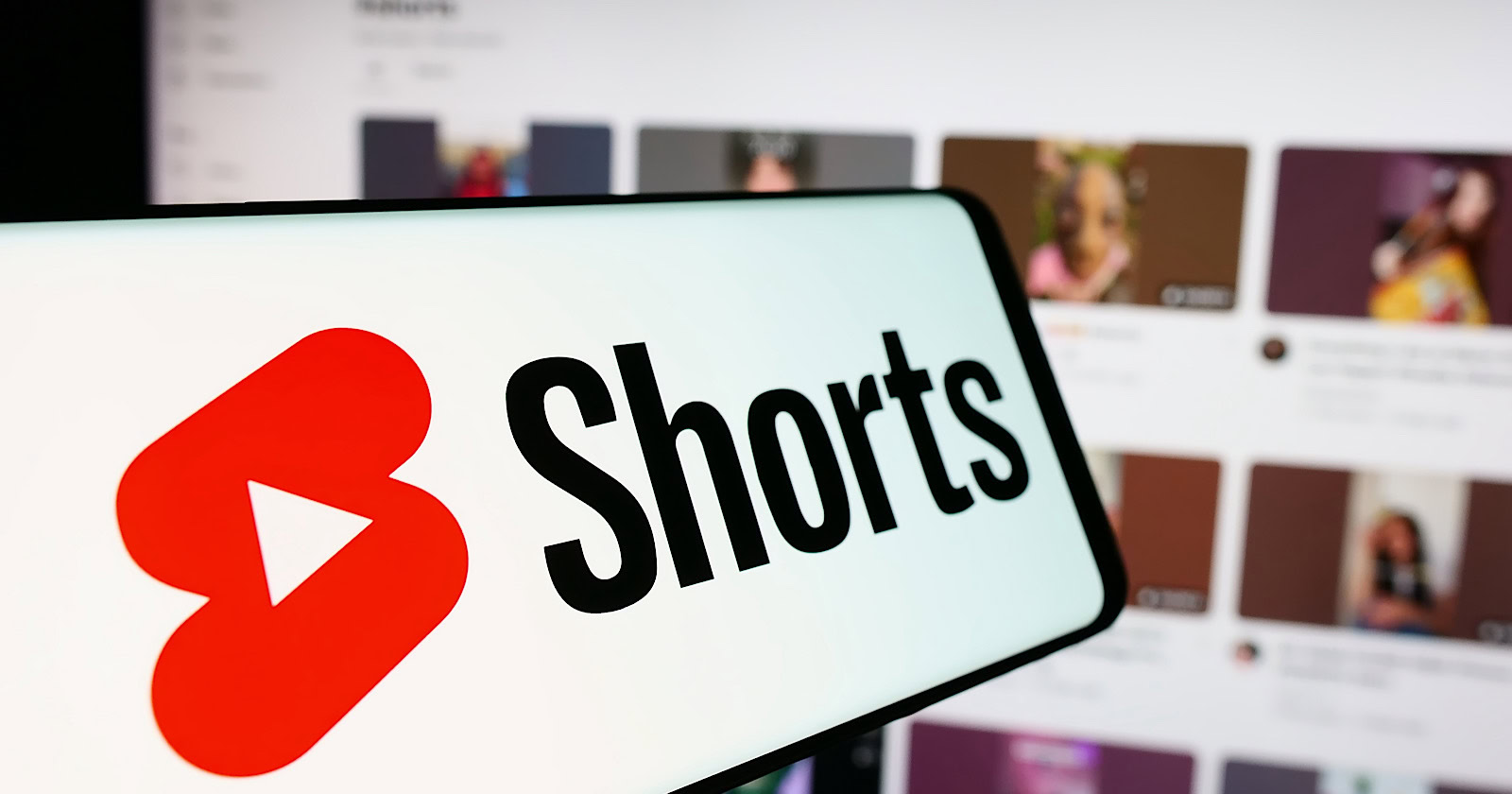
YouTube expands Shorts to 3 minutes, adds templates, AI tools, and the option to show fewer Shorts on the homepage.
- YouTube Shorts will allow 3-minute videos.
- New features include templates, enhanced remixing, and AI-generated video backgrounds.
- YouTube is adding a Shorts trends page and comment previews.
-

 WORDPRESS3 days ago
WORDPRESS3 days agoWordPress biz Automattic details WP Engine deal demands • The Register
-
SEARCHENGINES5 days ago
Daily Search Forum Recap: September 30, 2024
-

 SEO7 days ago
SEO7 days agoYoast Co-Founder Suggests A WordPress Contributor Board
-

 SEARCHENGINES6 days ago
SEARCHENGINES6 days agoGoogle Volatility With Gains & Losses, Updated Web Spam Policies, Cache Gone & More Search News
-

 SEO7 days ago
SEO7 days ago6 Things You Can Do to Compete With Big Sites
-
SEARCHENGINES4 days ago
Daily Search Forum Recap: October 1, 2024
-

 SEO6 days ago
SEO6 days agoAn In-Depth Guide For Businesses
-
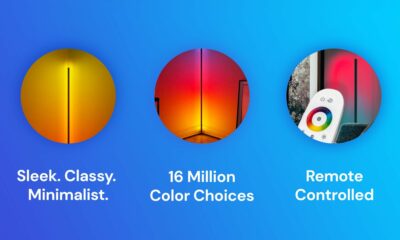
 AFFILIATE MARKETING6 days ago
AFFILIATE MARKETING6 days agoThis Minimalist Lamp Lets You Pick From 16 Million+ Lighting Colors for Maximum Productivity


